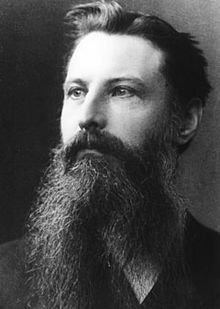Friedrich Wilhelm Zopf
Friedrich Wilhelm Zopf | |
|---|---|
 | |
| Born | 12 December 12 1846 |
| Died | 24 June 1909 (aged 63) |
| Nationality | German |
| Scientific career | |
| Fields | Botany and Mycology |
Friedrich (or Friederich) Wilhelm Zopf (12 December 1846 – 24 June 1909) was a well-known German
Early life
Wilhelm Zopf was born in Roßleben in Thuringia in 1846. Before going into biological science area, he has been an elementary school teacher in Thondorf at Mansfeld when he was 21-year-old.[4]
Education and research career
In 1874, Wilhelm Zopf decided to leave his teaching position and turned into studying natural sciences at the
Also in 1874,
He then received his PhD with a dissertation entitled “Die von Conidienfrüchte von Fumago (Translation: Conidia of Fumago)” at the University of Halle in 1878.[4]
As Wilhelm Zopf obtained his degree, simultaneously, he also went back to Berlin as an adjunct professor teaching at the Agricultural College for a few years. In 1883, he was invited to be a head of the cryptogamic laboratory at the
In 1884, Heinrich Georg Winter published Zopfiella which is a genus of fungi within the Lasiosphaeriaceae family and also named in Zopf's honour.[5]
In 1899, Wilhelm Zopf became a professor and a director of the botanical garden at the
Lastly, Wilhelm Kirschstein in 1939 published Zopfinula (another genus of fungi).[6]
Other scientific contributions
Wilhelm Zopf was the first people to carry out the chemical differences in lichens.[7] In 1907, his book “Die Flechtenstoffe in chemischer, botanischer, pharmakologischer und technischer Beziehung (Translation: The lichen substances in chemical, botanical, pharmacological and technical relationship)” was published. This book contained descriptions of over 150 chemical compounds found in lichens.[8] Little was known about the actual structures of many of those compounds, but his work gave a sounder basis for the use of chemistry in the taxonomy of lichens.[9]
Although
Selected publications
- Zopf, W. 1890: Die pilze in morphologischer, physiologischer, biologischer und systematischer Beziehung. Jena: E. Trewendt. 500 pp.
- Zopf, W. 1897: Zur Kenntniss der Flechtenstoffe (Vierte Mittheilung). Liebigs Annalen der Chemie 297: 271–312.
- Zopf, W. 1905: Biologische und morphologische Beobachtungen an Flechten. I. Berichte der Deutschen Botanischen Gesellschaft 23: 497–504.
- Zopf, W. 1906: Biologische und morphologische Beobachtungen an Flechten. II. 1. Über Ramalina kullensis n. sp. Berichte der Deutschen Botanischen Gesellschaft 24: 574 –580.
- Zopf, W. 1907: Die Flechtenstoffe in chemischer, botanischer, pharmakologischer und technischer Beziehung. Jena: G. Fischer. 450 pp.
- Zopf, W. 1908: Beiträge zu einer chemischen Monographie der Cladoniaceen. Berichte der Deutschen Botanischen Gesellschaft 26: 51–113.
See also
References
- ^ "Wilhelm Zopf". Martin-Luther-Universität Halle-Wittenberg. 2015.
- ^ ISBN 9781329874008.
- ^ Krüger, W (1894). "Kurze Charakteristik einiger niedrerer Organismen im Saftfluss der Laubbäume". Hedwigia. 33: 241–266.
- ^ a b c Kärnefelt, Ingvar; Scholz, Peter; Seaward, Mark; Thell, Arne (2012). "Lichenology in Germany: past, present and future". Schlechtendalia. 23: 1–90.
- ^ ISBN 978-3-946292-41-8. Retrieved January 27, 2022.
- ^ "Zopfinula". www.gbif.org. Retrieved 22 December 2022.
- .
- PMID 18250902.
- ^ "Chemistry after the 1860s". Australian National Botanic Gardens.
- ^ Zopf, Wilhelm (1888). "Zur Kenntnis der Infektionskrankheiten niederer Thiere und Pflanzen". Nova Academy of Caes. Leop. German. Nat. Cur. 52: 314–376.
- ^ "Some exceptions in biology: Worm-catching fungi". Baldscientist. 2014. Archived from the original on 2016-10-14. Retrieved 2016-09-29.
- ^ International Plant Names Index. Zopf.
External links
- Lichenology in Germany: past, present and future. [1] Archived 2022-01-21 at the Wayback Machine
